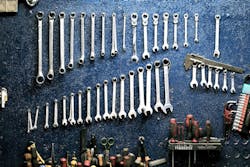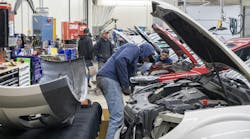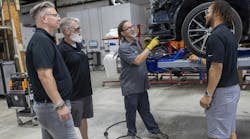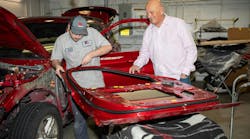For a shop that’s accustomed to fast-paced growth, the key to success lies not in going with the flow, but in striving to do better than before.
The key to success is doing the common, everyday tasks and performing them uncommonly well, says Andrew Suggs, co-owner of European Collision Repair in Sandy Springs, Ga.
“As crazy as it sounds, we went from one location to four locations in two different states within four years,” Suggs says.
In fact, the collision repair business boasted the first Tesla-certified collision repair facility on the east coast, attaining that in 2012.
Suggs isn’t alone in achieving massive, rapid growth for his body shop. Before he even stepped foot into the body shop, his father, Thomas, was pioneering shop growth. Suggs first was a professional golfer right out of college and it wasn’t until he got injured that he decided to follow in his father’s footsteps.
Suggs left the golf course behind but took with him the work ethic and an ability to make connections with different kinds of people. After starting in the shop as a detailer, Suggs worked his way up to run the front office.
“One of the most important aspects on the shop side is to create those instant connections with customers and make them feel comfortable,” he says.
Today, with its significant growth, European Collision Repair (ECR) has only one DRP and is heavily focused on carrying out solid routines and procedures, even across multiple locations. It pays off, too, as the business brings in roughly $18 million in annual revenue.
Overcoming Growing Pains
The collision repair business’s growth was dependent on a combination of factors, including finding markets to fill a need.
European Collision Repair first opened in Jonesboro, Ga., under Thomas Suggs’ guidance. Today, the elder Suggs still works out of that location and runs the main hub so that his son can focus on frequently visiting multiple locations.
A key moment in the business’s growth came back in 2012, when a Tesla was damaged in the Atlanta area, and the owners eventually called upon ECR. The business took that opportunity to become Tesla certified and thus, hastened its ascent.
Shortly after their second location opened in Nashville, the family opened a third location in the Atlanta area, soon followed by a fourth location in 2018 in Antioch, Tenn.
“It’s difficult to go from only one location, with the same crew of people for years, to multiple locations in more than one state,” Andrew Suggs says. “The challenge was getting everyone on the same page and following the same procedures.”
Suggs says shop owners looking to expand need to nail down their procedural routines (See Sidebar: Tools to Tackle Tasks). Suggs needed to implement goals for the shop to work toward daily, weekly, monthly and yearly. For example, he noted, “I’m going to sit down with the parts department to better understand where success lies and where bottlenecks occur for them.”
To streamline processes, he also created an employee handbook. The handbook contains every SOP ever created at the shop. Even the check-in process and customer greetings have their own SOPs.
The father-son duo chose to hire outside of the company and move around key players to train new employees. For instance, the manager from the Atlanta location was moved to general manager to help the transition. Some employees have now been with the body shop for over a decade.
Tools to Tackle Tasks
—
Using those tools, he checks these KPIs every day:
-
GP Reports
-
Sales
-
Average Repair
-
Capture Ratio
-
CSI
Tweaking Shop Workflow
Through the shop expansion, Suggs put his college education to use. He learned one of the best ways to organize the shop floor was to incorporate color-coding.
“People in general respond to color,” he says. “Now, everything has a color and reason for that color to make the process simple.”
For each ECR facility, the flow of work starts the same. A car is dropped off by the customer and brought into the disassembly cube area. The area has no shade or windows so that technicians can take ideal pictures of vehicle damage. And, for each step of the process, the technician working on the car dates and initials their notes on a sticker that’s affixed to the vehicle. At any given time, the team can look at the sticker and the name that’s on it to know who’s working on the vehicle.
Then the car is washed, goes on to the shop floor, and an estimate is attached to the car’s file.
Once the car is repaired, it goes into paint. Between the body repair zone and the paint zone, there’s a red zone, Suggs says. This zone is the “accountability zone.”
In this accountability area, the team knows that once a car is in, either the painter and body shop manager, or painter and general manager have to meet about it to double check work.
Basically, one technician from the beginning of the repair process has to meet with one working toward the end of the repair. The team will be notified about 30 minutes ahead of the car going into the red zone, either during the day’s production meeting or displayed on the shop’s electronic production board.
“It’s a meeting of the minds, if you will,” Suggs says. “A lot of times, it’s done in two stages, where the painter checks the bodyman’s work and then the bodyman will get together with say, the parts person, to make sure there are no issues or additional parts to order.”
The car goes on to paint and buffing, and then gets reassembled.
The body shop teams have been able to repair roughly 100 vehicles each month through the aforementioned process. Today, the average monthly car count for the Sandy Springs location is 125 cars.
By following the market demands, taking on opportunities presenting themselves and working hard to adjust to the challenges of the new ventures, the Suggs run an $18 million business today.
Accomplishing the Overarching Goal
Once routine, organization and procedures are in place and producing results, Suggs says the key is forming relationships. For instance, an important element that has kept a steady stream of work flowing into ECR during expansion was dealership partnerships.
“Customers now rely on dealerships for all things car-related, so those referrals are critical,” Suggs says.
Suggs follows his motto of under-promising and over-delivering when it comes to his dealership partnerships.
On the other hand, Suggs and his dad formed the relationship that keeps the shop running smoothly. When it comes to working alongside family, Suggs recommends to align each person’s vision and ideas for the company together.
Suggs and his father have different styles of management but always work toward the same goal. Suggs takes his time to implement a process to ensure it’s done right, while he says his father expects every job to be done correctly and done in a timely manner.
“Sometimes you feel like you’re chasing your tail going from location to location putting out fires, training, or building up employees,” he says. “If you’re not organized you can’t get a strategy to move your business forward.”
SHOP STATS: European Collision Repair Main Location: Sandy Springs, Ga. Operator:Thomas Suggs Average Monthly Car Count: 125 Staff Size: 7 Shop Size: 33,000 square. feet. Annual Revenue: $7 million



